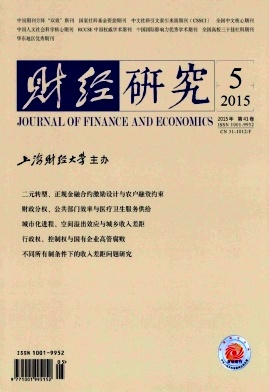FDI纵向一体化、技术转移与东道国产业发展
财经研究 2015 年 第 41 卷第 05 期, 页码:
摘要
参考文献
摘要
引进外商直接投资(FDI)一直被视为东道国实现技术升级和产业发展的重要途径;然而,FDI纵向一体化的进入模式有可能不利于东道国的产业发展。文章在双边寡占的框架下,将技术转移决策以及技术扩散效果引入Lin和Saggi(2011)的模型中,分析上下游FDI一体化与非一体化进入方式对东道国产业发展和福利的影响。研究表明:在本土企业技术能力不足时,上下游FDI一体化进入方式虽然会给东道国带来更多的先进技术转移,但这更有利于FDI提高自身的竞争优势,而且这种一体化的进入方式通过消除自身面临的“双重边际化”以及加剧东道国本土企业的“双重边际化”来挤压本土企业的利润,进而给东道国企业的利润和福利带来负向影响。文章不仅为外资带来的“产业升级悖论”提供了一种理论解释,而且也为我国引进外资的政策导向和改善引资质量提供了借鉴。
[1]王益民,宋琰纹. 全球生产网络效应、集群封闭性及其“升级悖论”——基于大陆台商笔记本电脑产业集群的分析[J]. 中国工业经济,2007,(4):46-53.
[2]谢建国. 市场竞争、东道国引资政策与跨国公司的技术转移[J]. 经济研究,2007,(6):87-97.
[3]邢斐,张建华. 外商技术转移对我国自主研发的影响[J]. 经济研究,2009,(6):94-104.
[4]杨飞. “嵌入型”集群中外资企业扎根失效机理分析——以珠三角东莞市清溪镇ICT产品集群为例[J]. 改革,2004,(4):52-56.
[5]于明超,刘志彪,江静. 外来资本主导代工生产模式下当地企业升级困境与突破——以中国台湾笔记本电脑内地封闭式生产网络为例[J]. 中国工业经济,2006,( 11):108-116.
[6]Aitken B J, Harrison A E. Do domestic firms benefit from direct foreign investment? Evidence from Venezuela [J]. American Economic Review, 1999, 89(3):605-618.
[7]Blomstrom M, SjoKholm F. Technology transfer and spillovers:Does local participation with multinationals matter [J]. European Economic Review, 1999, 43(4-6):915-923.
[8]Borensztein E, Gregorio J D, Lee J W. How does foreign direct investment affect economic growth [J]. Journal of International Economics, 1998, 45(1):115-135.
[9]Ethier W J, Markusen J R. Multinational firms, technology diffusion and trade[J]. Journal of International Economics, 1996, 41(1-2):1-28.
[10]Gaudet G, Long N V. Vertical integration, foreclosure, and profits in the presence of double marginalization[J]. Journal of Economics & Management Strategy, 1996, 5(3):409-432.
[11]Jansen J. Coexistence of strategic vertical separation and integration[J]. International Journal of Industrial Organization, 2003, 21(5): 699-716.
[12]Lin P, Saggi K. Multinational firms, exclusivity, and backward linkages[J]. Journal of International Economics, 2007, 71(1):206-220.
[13]Lin P, Saggi K. Foreign direct investment in a two-tier oligopoly:coordination, vertical integration, and welfare[J]. International Economic Review, 2011, 52(4):1271-1290.
[14]Mattoo A, Olarreagaa M, Saggi K. Mode of foreign entry, technology transfer,and FDI policy[J]. Journal of Development Economics, 2004, 75(1):95-111.
[15]Norman H. Vertical integration, rising rivals’ costs and upstream collusion[J]. European Economic Review, 2009, 53(4):461-480.
[16]Ordover J A, Saloner G, Salop S C. Equilibrium vertical foreclosure[J]. American Economic Review, 1990, 80(1):127-142.
[17]Pack H, Saggi K. Vertical technology transfer via international outsourcing[J]. Journal of Development Economics, 2001, 65(2):389-415.
[18]Riordan M H. Competitive effects of vertical integration[M].Cambridge,MA:Handbook of Antitrust Economics, MIT Press, 2008.
[19]Saggi K. Foreign direct investment, licensing, and incentives for innovation[J]. Review of International Economics, 1999, 7(4):699-714.
[20]Salinger M A. Vertical mergers and market foreclosure[J]. The Quarterly Journal of Economics, 1988, 103(2):345-356.
[2]谢建国. 市场竞争、东道国引资政策与跨国公司的技术转移[J]. 经济研究,2007,(6):87-97.
[3]邢斐,张建华. 外商技术转移对我国自主研发的影响[J]. 经济研究,2009,(6):94-104.
[4]杨飞. “嵌入型”集群中外资企业扎根失效机理分析——以珠三角东莞市清溪镇ICT产品集群为例[J]. 改革,2004,(4):52-56.
[5]于明超,刘志彪,江静. 外来资本主导代工生产模式下当地企业升级困境与突破——以中国台湾笔记本电脑内地封闭式生产网络为例[J]. 中国工业经济,2006,( 11):108-116.
[6]Aitken B J, Harrison A E. Do domestic firms benefit from direct foreign investment? Evidence from Venezuela [J]. American Economic Review, 1999, 89(3):605-618.
[7]Blomstrom M, SjoKholm F. Technology transfer and spillovers:Does local participation with multinationals matter [J]. European Economic Review, 1999, 43(4-6):915-923.
[8]Borensztein E, Gregorio J D, Lee J W. How does foreign direct investment affect economic growth [J]. Journal of International Economics, 1998, 45(1):115-135.
[9]Ethier W J, Markusen J R. Multinational firms, technology diffusion and trade[J]. Journal of International Economics, 1996, 41(1-2):1-28.
[10]Gaudet G, Long N V. Vertical integration, foreclosure, and profits in the presence of double marginalization[J]. Journal of Economics & Management Strategy, 1996, 5(3):409-432.
[11]Jansen J. Coexistence of strategic vertical separation and integration[J]. International Journal of Industrial Organization, 2003, 21(5): 699-716.
[12]Lin P, Saggi K. Multinational firms, exclusivity, and backward linkages[J]. Journal of International Economics, 2007, 71(1):206-220.
[13]Lin P, Saggi K. Foreign direct investment in a two-tier oligopoly:coordination, vertical integration, and welfare[J]. International Economic Review, 2011, 52(4):1271-1290.
[14]Mattoo A, Olarreagaa M, Saggi K. Mode of foreign entry, technology transfer,and FDI policy[J]. Journal of Development Economics, 2004, 75(1):95-111.
[15]Norman H. Vertical integration, rising rivals’ costs and upstream collusion[J]. European Economic Review, 2009, 53(4):461-480.
[16]Ordover J A, Saloner G, Salop S C. Equilibrium vertical foreclosure[J]. American Economic Review, 1990, 80(1):127-142.
[17]Pack H, Saggi K. Vertical technology transfer via international outsourcing[J]. Journal of Development Economics, 2001, 65(2):389-415.
[18]Riordan M H. Competitive effects of vertical integration[M].Cambridge,MA:Handbook of Antitrust Economics, MIT Press, 2008.
[19]Saggi K. Foreign direct investment, licensing, and incentives for innovation[J]. Review of International Economics, 1999, 7(4):699-714.
[20]Salinger M A. Vertical mergers and market foreclosure[J]. The Quarterly Journal of Economics, 1988, 103(2):345-356.
引用本文
邢 斐, 宋 毅. FDI纵向一体化、技术转移与东道国产业发展[J]. 财经研究, 2015, 41(5): 0.
导出参考文献,格式为:





 6733
6733  3050
3050

